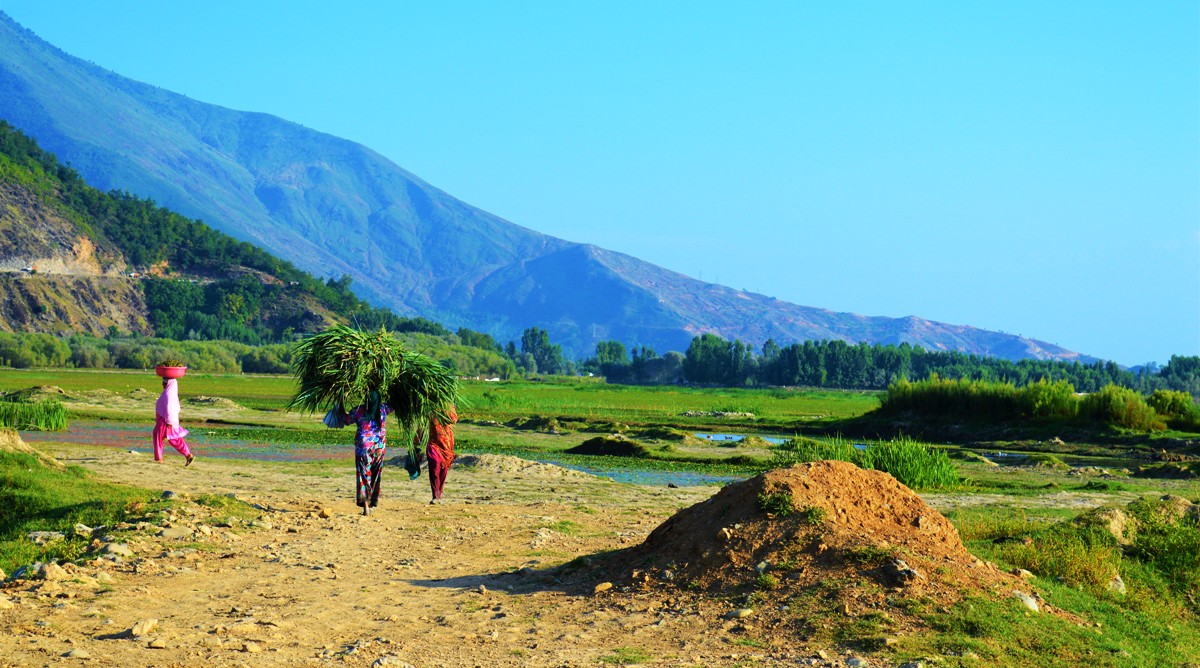by Athar Parvaiz
After dithering over it for years, the Department of Forest, Ecology, and Environment uploaded the draft of State Environment Policy (SEP) 2018 on its website in August inviting comments and suggestions from various government departments and civil society within a month through emails.

J&K government had started working on the SEP ever since the National Environment Policy (NEP) was announced in 2006 by the government of India.
The dominant theme of NEP is mainstreaming environmental concerns into all developmental activities. It emphasizes that while conservation of environmental resources is necessary to secure livelihoods and well-being of all, the most secure basis for conservation is to ensure that people dependent on particular resources obtain better livelihoods from the fact of conservation than from degradation of the resource.
The SEP draft of J&K government, which was first drafted in 2012, but never put in the public domain until August 2018, recommends measures for protecting state’s critical ecological systems and efficient use of environmental resources.
But despite four months since the draft was uploaded, the forest department has not heard from the stakeholders which are part of the Jammu & Kashmir government. These stakeholders include the government’s Tourism, Industries, Agriculture, Housing and Urban Development and other government departments.
“We reminded them about their response even before uploading the draft on the website as we had shared the draft with them. And, after the draft was uploaded on the website, we sent them official reminders twice. But we got no response,” an official of the forest department told this writer while pleading anonymity. “The comments and suggestions we have got so far, have only come from civil society.”

When contacted, Commissioner Secretary of J&K’s Forest, Ecology and Environment Department, Manoj Kumar Dwivedi, said that his department is hopeful about having responses of other departments of the government very soon. “Now we are planning to send our officials to the concerned departments so that we have their response. Their participation is very crucial for successful implementation of the environmental policy once it is in place,” Dwivedi told this writer.
The anonymous official of forest department said that the SEP would have been even sent for the cabinet approval by now had the policy been finalized. “The stakeholders (government departments) are trying their best to delay the process,” he opined.
Identifying the key environmental challenges, the SEP draft puts much emphasis on protection of wetlands, forests and rivers of Jammu & Kashmir and underscores the need of putting an end to alarming air pollution and soil contamination.
“Unfortunately, our unique wetlands are facing tremendous ecological stress primarily because they are visualized only as a source of water, ignoring their vitality as a holistic biotic system,” a section of the SEP draft reads. “In spite of being the very productive ecosystems, wetlands are confined mainly to Kashmir valley. The remaining patches are also facing increasing threats, especially from new industrial and infrastructure development projects including tourism and housing. The impact of this on the fishing sector is recognized, but inadequately addressed and is a classical example of the need for integrating the sectoral planning process.”
The draft further reads: “It is a matter of serious concern that tonnes of chemical fertilizers are being pumped into the agricultural land in the name of increasing productivity and, chemical pesticides, even those banned, are sprayed indiscriminately, again, in the name of protecting the crop from pests. As a result, today, analyses of pesticide residues in the State show that most of our food and water are contaminated at various levels.”
According to the SEP draft, the forests [of J&K] are degrading alarmingly and the biodiversity base is shrinking, disrupting the ecology seriously; especially the pristine faunal and floral life. “These lead to alarming fall in water availability in the rivers and other wetland systems and, also to landslides and heavy sedimentation of reservoirs. J&K continues to lose its biodiversity at alarming rates due to habitat destruction, overgrazing, deforestation, pollution, unsustainable harvesting of natural resources, and the introduction of invasive and alien species, among others.”
Mayor ignored wetland vitality
Whether strict environmental laws are in place or not, those in power care little about environmental protection.
Expressing dismay over government’s lack of interest for wetland protection, the president of Peoples’ Environmental Council (PEC), a Srinagar based environmental watchdog, Ghulam Hassan Kango, referred to the “insensitive” remarks expressed by the recently elected new mayor of Srinagar, Junaid Mattu, about wetlands.
“We will strike a balance between development and ecology but that doesn’t mean putting a chastity belt around the city… what are wetlands for? Watching birds?),” the Mayor had opined while addressing a press conference.
“Such remarks give us an idea about government’s catastrophic plans regarding the future of wetlands in Srinagar city,” Kango said.
The destruction being caused to natural resources such as wetlands is not only posing a threat of repeated flooding in many parts of the Indus basin but can negatively influence the availability of livelihood options for communities which depend on wetlands for fodder, fishing and eco-tourism. The large-scale destruction during September 2014 floods in Kashmir was widely attributed to haphazard development in Kashmir’s major towns as developmental and housing infrastructure has been raised in erstwhile flood basins (wetlands) of the region in recent years.
Wetlands under spotlight
Thankfully, sustained pressure on governments from activists, media and judiciary seem to have brought wetlands under some spotlight.

In August last year, the Jammu and Kashmir High Court directed the state government to demarcate the wetlands and take measures to conserve water bodies in the Valley. As a result, demarcation of wetlands in the state is being carried out, but officials say that they are dealing with a lot of confrontation from encroachers.
“Recently, around 1000 people surrounded our officials and disrupted the demarcation process in the Hokersar wetland. Those who have encroached upon wetlands over the decades are creating a lot of hurdles. But that doesn’t mean we will relent,” said Rashid Naqash, Regional Wildlife Warden of Kashmir.
Naqash’s colleague, Rouf Zargar, who heads the central wildlife region in Kashmir, said that ever since the prominent wetlands of Kashmir were notified way back in 1946 by the then ruler of Kashmir, “demarcation of original extent of wetlands has never been carried out which has allowed people to encroach upon wetland areas.” So, he said, the demarcation process is taking time.”
On September 26, 2017, the Union Ministry of Environment, Forests & Climate Change (MoEF&CC) notified a new set of rules, The Wetlands (Conservation and Management) Rules 2017, which replaced the earlier set of guidelines notified in 2010.
According to the 2017 rules, each state “has to set up a State Wetlands Authority that will be headed by the State’s environment minister and include a range of government officials. They will also include one expert each in the fields of wetland ecology, hydrology, fisheries, landscape planning and socioeconomics to be nominated by the state government.”
“But, nothing has happened so far in this direction as regards Jammu & Kashmir,” Kango said.
Vanishing wetlands
The massive urban expansion in Srinagar and some major towns of Kashmir is consuming the region’s wetlands. A study carried out by Humayun Rashid and Gowhar Naseem of Department of Environment, Ecology and Remote Sensing (government of Jammu & Kashmir), says that more than 50 per cent of water bodies in Srinagar and its suburbs have been lost during the past century.
“The comparative change analysis of the two maps based on the year 1911 and 2000 reveal that wetlands like Batamaloo Nambal, Rakh-i-Gandakshah and Rakhi-i-Arat and Rakh-i-KhanKhan besides streams of Doodhganga and Nala Mar have been completely lost while other lakes and wetlands have experienced considerable shrinkage during the last century,” the study says.
The loss of water bodies of Srinagar and its suburbs is attributed to heavy population pressures. “Besides siltation brought about as a result of wanton deforestation in the catchments of Kashmir [rivers] has also been an important factor that enhanced the land-use/land-cover change.”
Srinagar city has grown 12 times in terms of population and 23 times in terms of the area between 1901 and 2011. A report in 2011 said that Srinagar city is one of the 100 fastest growing urban areas in the world.
Siltation due to deforestation is another major reason for declining water bodies in Kashmir.
“Due to the increased siltation, the marshy lands have fragmented… Excess load of siltation has also adversely affected the depth of the wetland which was 1.12 metres and has reduced to only 0.63 metres,” Romshoo of Kashmir University’s Earth Sciences department said, quoting from his research paper on the impacts of changing land cover and climate on Hokersar wetland.
Marshy lands, Romshoo said have been steadily declining — from 16.3 square kilometres in 1969 to 5.62 square kilometres in 2008. In 1969, marshy land covered 85% of the wetland area.
The wetland, too, has shrunk from 18.75 square kilometres in 1969 to to13 square kilometres in 2008, Romshoo said.
Another deteriorating wetland is the Wular Lake 34 km north-west of Jammu & Kashmir’s summer capital, Srinagar. Once known for its depth and pristine waters, the lake has, however, witnessed large-scale degradation in recent decades. Wular has been an international Ramsar site since 1990 under Ramsar Convention. It is regarded as the largest flood basin in the Kashmir region.

In a detailed study of the lake, Wetlands International says that the original area of Wular Lake was 217.8 sq km which included 58 sq km of associated marshes. The area, says the study, was reduced from 157.74 sq. km to 86.71 sq km from 1911 to 2007. Overall, there was a reduction in the lake area by 45% mainly due to the conversion of parts of the lake for agriculture and willow tree plantation, the study says.
The Himalayan wetlands play an important role in storing and cleaning water that flows into major rivers like the Indus and acts as a buffer between glacial meltwaters and outflows to smaller rivers and streams. Any change to these wetlands will affect flooding and the availability of water for communities living in downstream river basins.
(Author writes on ecological issues. This article was first published by Mongabay.)















